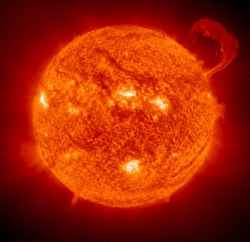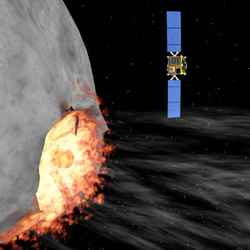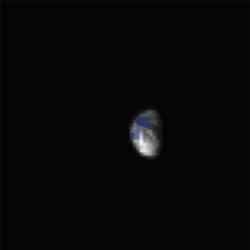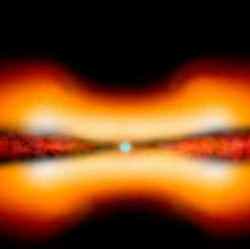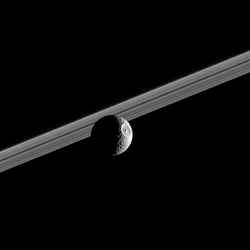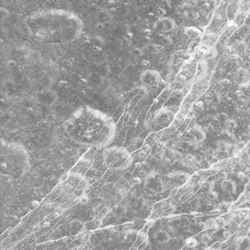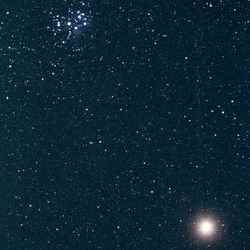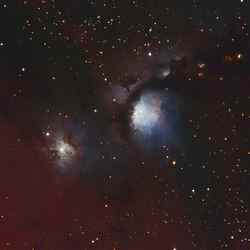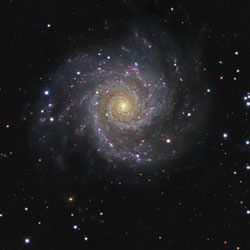
M74. Image credit: R. Jay GaBany. Click to enlarge.
Monday, November 28 – Tonight let’s begin by identifying the marker star we will need to make our first galaxy hop – Eta Pisces. The stars of this constellation are rather dim, but try this simple trick: the southernmost star in the “Great Square of Pegasus” is Gamma. You will find Eta about a handspan due east. By centering on Eta, shift east-northeast less than one fingerwidth…
The large spiral galaxy M74 was first observed by Pierre Mechain in 1780. This vague, misty-appearing deep sky object is probably one of the most difficult Messier objects you will ever try to find, but when you do – don’t be disappointed. Even the great John Herschel had trouble correctly identifying it! Even at 11th magnitude, its low surface brightness will make it appear as nothing more than a round, diffuse glow in small scopes, but larger ones will find a condensation towards the nucleus and just a whisper of spiral structure with excellent seeing conditions. Best of luck!
Tuesday, November 29 – Tonight let’s start with Mira and hop about three fingerwidths northeast to Delta Ceti. About one degree to the southeast you will discover our next galaxy – M77.
At magnitude 10, this bright, compact spiral galaxy can even be spotted with larger binoculars as a faint glow and is unmistakable as a galaxy in smaller scopes. Its small bright nucleus shows well in mid-sized scopes, while larger ones will resolve out three distinctive spiral arms. But this “Seyfert” galaxy isn’t alone… If you are using a larger scope, be sure to look for 11th magnitude edge-on companion NGC 1055 about half a degree to the north-northeast, and fainter NGC 1087 and NGC 1090 about a degree to the east-southeast. All are part of a small group of galaxies associated with the 60 million light-year distant M77.
Wednesday, November 30 – Tonight let’s go north for a mid-size scope challenge about two fingerwidths east-northeast of the beautiful double star Gamma Andromeda.
The 12th magnitude NGC 891 is a perfect example of a spiral galaxy seen edge-on. To the mid-sized scope, it will appear as a pencil-slim scratch of light, but larger telescopes will be able to make out a fine, dark dust lane upon aversion. Discovered by Caroline Herschel in 1783, NGC 891 contained a magnitude 14 supernova event recorded on August 21, 1986. Often considered a “missed Messier,” you can add this one to your Caldwell list as number 23!
Thursday, December 1 – Born today in 1811 was Benjamin (Don Benito) Wilson. He was the namesake of Mt. Wilson, California.
Tonight is New Moon and time for big scopes to get serious. Return to NGC 891 and head another degree or so to the southeast to take on the Abell 347 Galaxy Cluster. Here you will find a grouping of at least a dozen galaxies that can be fitted into a wide field view. Let’s tour a few…
The brightest and largest is NGC 910 – a round elliptical with a concentrated nucleus. To the northwest you can catch faint, edge-on NGC 898. NGC 912 is northeast of NGC 910, and you’ll find it quite faint and very small. NGC 911 to the north is slightly brighter, rounder, and has a substantial core region. NGC 909 further north is fainter, yet similar in appearance. Fainter yet is more northern NGC 906 and shows as nothing more than a round contrast change. Northeast is NGC 914, which appears almost as a stellar point with a very small haze around it. To the southeast is NGC 923 which is just barely visible with wide aversion as a round contrast change. Enjoy this Abell quest!
Friday, December 2 – Today in 1934, the largest mirror in telescope history began its life when the blank for the 200-inch telescope was cast in Corning, New York. But, tonight you won’t need aperture that large as we seek out two more sky gems – one for the north and one for the south.
Located in western Perseus just slightly less than one degree north-northwest of Phi, M76 is often referred to as “The Little Dumbbell.” Originally discovered by Messier’s assistant M?chain in September of 1780, Charles didn’t get around to cataloging it for another six weeks. What a shame it took him so long to view this fine planetary nebula! Its central star is one of the hottest known, but its resemblance to M27 is what makes it so fascinating. Looking very much like a miniaturization of the much larger M27, M76 is rather faint at magnitude 11, but is quite achievable in scopes of 114mm in aperture or larger. It is small, but its irregular shape makes this planetary nebula a real treat.
For our Southern Hemisphere friends, get thee out there and view Eta Carinae! First recorded by Halley in 1677, this nebular variable star left even the great Sir John Herschel at a loss to describe its true beauty and complexity This “slow nova” is filled with all the wonders the we “northerners” can only dream about…
Saturday, December 3 – Today in 1971, Soviet Mars 3 became the first spacecraft to make a soft landing on the red planet, and two years later on this same date the Pioneer 10 mission became the first spacecraft to fly by Jupiter. One year later on this same date? Pioneer 11 did the same thing!
Although we can’t land on Mars, we can certainly make the journey with our eyes as the planet is now very well placed in the early evening hours for viewing. Be sure to look for the deep, dark triangle of Syrtis Major highlighted by Hellas Basin. Perhaps at your viewing time it might be the long expanse of Amazonis Planitia or the “fingers” of Mare Erythraeum. Even if you don’t use a telescope, just seeing Mars shining so brightly is worth the trip outside! And Jupiter?
You’ll find it just before dawn…
Sunday, December 4 – Today in 1978, the Pioneer Venus Orbiter became the first spacecraft to orbit Venus. Is Venus still around? You bet. Just have a look right after sunset… You’ll find both it and the tender crescent Moon very close together…
Now wait until the Moon sets and let’s take on one more galaxy quest before we return to lunar studies. What shall we chose? Let’s try a very large and elusive galaxy that can be spotted with binoculars, and even unaided, from a very dark observing site – M33.
The “Triangulum Galaxy” is very misty, vague and also a totally wonderful galaxy for study. Just west of Alpha Triangulum, this galaxy is about the size of the full Moon, but it is so diffuse it’s sometimes hard to locate. Cataloged by Charles Messier in August 1764, M33 is often known as the “Pinwheel.” because of its distinguishable arm structure. As a part of our local galaxy group, M33 (NGC 598) is quite prized by amateurs for its ability to resolve. It has a distinct concentration toward the nucleus area plus a northern and southern “arm” that are within a small telescope’s capabilities. Telescopes ranging from 12.5″ to 16″ and larger will find a wealth of NGC and IC objects hiding within this fantastic galaxy, allowing us to study star clusters and nebulae almost 750,000 light-years away. It’s out there tonight!
My many thanks go to Ken and to all of you nice folks who take the time to write! Wishing you all clear, dark skies and may all of your journeys be at light speed… ~Tammy Plotner

